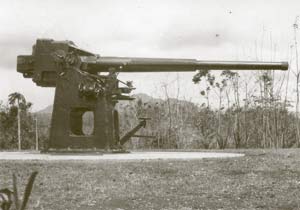Anti-Aircraft Defenses
Fixed and Mobile Mounts
|

This picture of a 3-inch M1917
anti-aircraft gun
was taken at Fort Amador near the Panama Canal
in the 1920's. No photographs of the M1917 guns at
Fort
MacArthur have yet been found. |
During the earliest days the
twentieth century, not much thought was given to the idea of
defending the fort against attack from the sky. At that
time, powered flight was limited to a few slow moving
airships and aircraft were made mostly of wood and canvas.
When World War One broke out in 1914 air power was in its
infancy, but it grew to be force to be reckoned with by
1918. Most
air operations at that time consisted of activities such as
obtaining information about troop movements, photographing
defenses, and the making maps for the combatant armies. That
activity caused the development of aerial combat aircraft,
at first to prevent reconnaissance activity, and later
for use against ground forces. |
After the war ended, continued advances in general aviation,
lighter-than-air commercial aviation, and the lessons
learned during the war, caused the US Army to begin looking
for a way to defend against the aircraft. The process was
slow because the aircraft was still seen as only a limited
threat due to the limited distance of flight and the fact
that the United Stated was well insulated from Europe and
Asia by the Atlantic and Pacific oceans.
On May 21st 1920, not long after the construction was
finished on the major guns of Fort MacArthur, work commenced
on the installation of four 3-inch Model 1917 guns at two
locations around the fort. The first location was on the
lower reservation near the top of the bluff over looking the
harbor and near the site of the radio station. The second
location was a position set between White Avenue and
Constellation Way on 25th Street. A few months before the
start of WWII the four guns were removed from their original
mounts, reconditioned and remodeled. The new guns were
designated the 1917-A2 and beginning in January of 1942 a
new set of fixed positions for three of the guns was built
on the upper reservation just behind the site that is today
occupied by the Korean Friendship Bell and Battery 241.
Beginning just after the First World War and continuing
until about 1938, successive developers worked to create a
mobile anti-aircraft gun that would later be adopted as the
37mm M1A1 and M1A2. Fort MacArthur had a small number of
these guns in inventory, but their lifespan at the fort was
short lived due to their light shell weight, short range and
slow rate of fire.
Two new designs were on the horizon that offered a larger
shell, superior rate of fire and faster tracking of
aircraft. In 1938 the Army issued a new set of requirements
for anti-aircraft guns to counter the continued development
of faster and more robust aircraft. By this time, the
aircraft carrier also had now become a recognized force in
naval operations.
|
During the years leading up to WWII, the army began
developing a new and much more powerful gun. The 90mm M1A1
was at best a semi-fixed weapon that could fire a 23lb shell
almost five times further than the older 37mm design. The
heavy firepower of this design combined with its portability
meant that it could be positioned in locations positions
around the fort, or in surrounding communities.
During WWII a number of these guns were stationed near the
Long Beach Airport to protect the Douglas Aircraft plant,
near the shoreline at Bluff Park in Long Beach, on the
athletic fields of local area high schools, and in city
parks where the large open areas provided a clear field of
fire into the night sky.
As good as the 90mm gun was the army still had a |

A 40mm gun crew from Fort MacArthur pose
for
this World War Two period photograph. |
|
need for an anti-aircraft
gun that could be manned by smaller crews while still
providing reliable firepower at intermediate ranges. The Bofors 40mm M1 Automatic Gun was developed in Sweden in the
1930ís and found its way into American manufacture in 1940.
Delays in production and a greater need by the navy meant
that it would not be full deployed with the army until 1943.
Both the 90mm and 40mm guns were so successful that they
continued to be used in modified forms long after world war
two.
|
Smaller anti-aircraft guns also
played a roll in protecting the harbor. The .30 caliber
M1917 Machine gun had been in use with the army since the
end of World War One. The biggest drawback to the M1917 was
its short effective range. The fort also had the much larger
Browning M1921 .50 caliber machine gun. This newer gun had
the ability to be mounted as a ground-based weapon, in
vehicles, and in aircraft.
The M1921 is probably the
most versatile heavy machine gun that has ever been produced
for the United States and is still in use to this day. Both
guns played a duel roll at Fort MacArthur by providing
perimeter security and short range anti-aircraft defense
mostly against fast moving low flying targets. |

Two cast members from the Hey Rookie Show
man a
.30 caliber M1917 water-cooled machine gun in 1943 |
|
 |
|
The Guns of Fort MacArthur |
 |
|
|
|